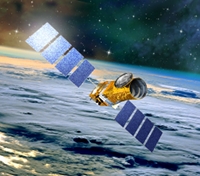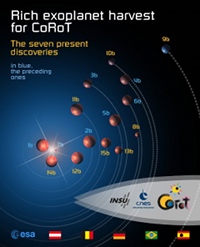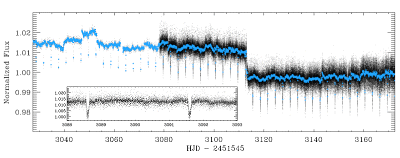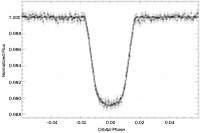CoRoT unveils a rich assortment of new exoplanets
14 June 2010
By detecting the faint dimming in the light emitted by stars during a transit event, CoRoT has detected six new exoplanets - each with its own peculiar characteristics - and one brown dwarf. One of these exoplanets, designated CoRoT-11b, has twice the mass of Jupiter and orbits a rapidly rotating star; this type of star is an extremely difficult target for exoplanet searches and its detection marks a significant achievement for the CoRoT team.
 |
|
The CoRoT spacecraft. |
Other geometrical configurations of a stellar system, for instance the presence of one or more companion stars can, however, mimic the presence of a planet. For this reason follow-up observations are needed to confirm the planetary nature of the transiting body. Alerted by CoRoT's detection of a candidate planet-hosting star, some of the foremost ground-based observatories collect high-resolution images and spectra, yielding a wealth of additional information.
In particular, astronomers look for a Doppler shift in the stellar spectrum, highlighting the periodic 'wobble' of the star in the two-body system. From the amplitude of this wobble, it is possible to estimate the mass of the transiting body and, consequently, to determine whether or not it is indeed a planet. Once the mass and the radius are known, the mean density of the planet can be derived – a key factor in distinguishing between gaseous giant planets and rocky terrestrial ones. The discovery of these six new exoplanets adds variety to the large number of exoplanets that have been detected to date.
"With the addition of this new batch, the number of exoplanets discovered by CoRoT has risen to 15," says Magali Deleuil from Laboratoire d'Astrophysique de Marseille, Head of the CoRoT exoplanet programme. "The increasing size of the census, which includes objects with very diverse characteristics, is of vital importance for a better understanding of planetary systems other than our own," she adds.
 |
|
The CoRoT family of exoplanets. Credit: CNES |
"The rich diversity emerging from this sample is a very interesting result, showing CoRoT's ability to detect exoplanets which are rather different from each other", comments Malcolm Fridlund, ESA's Project Scientist for CoRoT. "Being able to study a wide variety of planets will provide important insights into the formation and evolution of planetary systems", he adds.
One of the planets, CoRoT-11b, stands out from the set of six because of the rotation velocity of CoRot-11, its parent star, which spins around its axis in less than 2 days - an exceptionally high speed, as compared to the Sun's rotation period of about 26 days.
"This is the third exoplanet discovered around such a rapidly rotating star", notes Davide Gandolfi, the ESA Research Fellow who led the study of CoRoT-11b. "Because of the fast rotation of its host star, such a planet could only have been discovered because it transits in front of it, thus only a transit-hunter, such as CoRoT, could have spotted it", he adds.
The search for Doppler shifts in the spectra of stars, which represents another prolific method for detecting exoplanets, is in fact biased against planets orbiting fast rotators, as the high rotational velocity of the star makes it extremely hard to achieve high-precision Doppler measurements and hence to detect the tiny signature of the presence of a planet. "If it had been included as a possible exoplanet candidate during such a campaign, CoRoT-11b would have been rejected because of the intensive observational effort needed to achieve the required accuracy", explains Gandolfi.
Instead, the object was first noticed by CoRoT, and then became the subject of extensive photometric and spectroscopic follow-up observations across the world, using the Swiss Leonhard Euler
 | |
|
Above: The complete lightcurve of CoRoT-11 for the period 15 April to 7 September 2008. |
 |
"This result anticipates what may be achieved by future space-based missions searching for exoplanets", says Fridlund. CoRoT is in fact a precursor for PLATO, a Cosmic Vision candidate mission that will seek planetary transits over a much larger sample of stars - the size of the sample is an important factor determining the number of planets that may be discovered. This significant increase in the sample size is possible because of PLATO's very wide field of view, which in turn relies on the combined use of 34 small telescopes. In addition, PLATO will study brighter stars than those that can be observed with CoRoT, making it possible to determine the age of the planet-hosting stars through asteroseismology measurements. This, combined with the tremendous improvement in the accuracy on the estimate of exoplanet masses and sizes that is expected from PLATO, will provide an important step in the quest to understand the conditions that favour the formation of Earth-like planets.
Notes for editors
Since 1995, astronomers have discovered over 450 exoplanets by employing a number of techniques, including astrometry, radial velocity and the transit method. Of the 82 planets that have been discovered using the transit method, 15 were first spotted by CoRoT.
The CoRoT satellite has been developed and is exploited by the French national space agency, CNES, with significant participation from Austria, Belgium, the European Space Agency (ESA), Germany, Spain, and Brazil.
ESA has joined the mission by providing the optics and baffle for the telescope and testing of the payload. Through this collaboration a number of European scientists, from Denmark, Switzerland, the United Kingdom and Portugal, have been selected as Co-Investigators in open competition. As a result of ESA's participation in CoRoT, scientists from ESA's Member States also have access to the satellite's data.
ESA's Research and Scientific Support Department (RSSD) at ESTEC is a full partner in CoRoT by providing the on-board Data Processing Units (DPU's).
The ESA PRODEX programme has supported the development of the CoRoT telescope baffle, and the software development and data processing of CoRoT light curves.
The ground stations used for CoRoT are located in Kiruna (S), Aussaguel (F) Hartebeesthoek (South Africa), and Kourou (French Guyana), with mission-specific ground stations in Alcantara (Brazil) and Vienna (A).
A number of ground-based telescopes support CoRoT observations and contribute to the characterization of planets: the Canada France Hawaii Telescope, Hawaii, USA; the IAC80 and the ESA-OGS of Teide Observatory, Spain; the
Related publications:
Gandolfi, D., et al., "Transiting exoplanets from the CoRoT space mission XII. CoRoT-11b: a transiting massive 'hot-Jupiter' in a prograde orbit around a rapidly rotating F-type star", submitted to Astronomy and Astrophysics.
Contacts
Malcolm Fridlund, ESA CoRoT Project Scientist, ESA PLATO Study ScientistResearch and Scientific Support Department
Science and Robotic Exploration Directorate, ESA, The Netherlands
Phone: +31-71-5654768
Email: malcolm.fridlund
 esa.int
esa.int
Davide Gandolfi, ESA Research Fellow
Research and Scientific Support Department
Science and Robotic Exploration Directorate, ESA, The Netherlands
Phone: +31-71-5655343
Email: dgandolfi rssd.esa.int
rssd.esa.int

